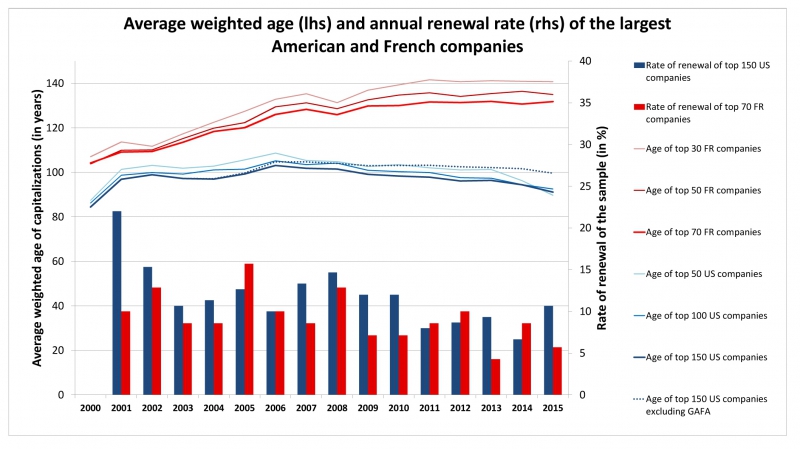
This post lays out an approach that makes it possible to confirm that this superior American dynamism translates into a faster renewal of very large market capitalizations.
The economic literature indicates that firm age is usually negatively correlated with sales, productivity and employment growth rates, as well as with their variance[1]. In other words, young firms have higher growth potential than mature firms, even if their growth rates are more erratic. This is all the more true when it comes to employment growth (Coad et al., 2013; Haltiwanger et. al., 2013). Age is also negatively correlated with the capacity to convert employment growth into productivity, sales and profits growth (Coad et al., 2013). Consequently, young firms have a greater incentive than mature firms to focus on workforce growth.
Having young firms that are able to grow rapidly is therefore important for an economy’s productivity, employment rate and propensity to innovate. It is worth noting that France and the US do not differ in terms of their share of young firms but rather in the latters’ average growth rate (Criscuolo et. al., 2014). These results confirm Barelsman’s et al. (2005), and an OECD report on innovation policy draws similar conclusions for innovative firms (OECD, 2014). Clearly in the US survival of the fittest is more potent than in France. Resources are also reallocated from less productive to more productive firms at a greater rate in the US (Sode, 2016).
Philippon and Véron (2008) show that this dynamic is also greater for very large companies. They observe that the largest American companies are more likely to have their rank in the hierarchy challenged by competitors than their European counterparts are. According to the consulting firm Innosight (2012), the rate of renewal of the top 500 American market capitalizations has strongly accelerated since the mid-90s.
In this post, we update these analyses by focusing on the largest firms so as to take into account the giants of the digital and high-tech sectors. To do so, we look at the level and evolution of the average age of very large companies’ market capitalizations in France and in the US. This average age can be thought of as an indicator for the largest companies in terms of the extent of their renewal process and the capacity of the relatively young firms among them to grow significantly. For each country, the index of average age is the sum of the ages of each firm weighted by the share of the firm in the total market capitalization of the sample for the country. We use a database created by Véron (2008) – which we update and complete – plus Datastream to obtain the market capitalizations and ages of firms in the S&P 500 and Cac All Shares indexes.
The index is computed for each year based on the list of the top 150 American capitalizations and the top 70 French ones. To ensure an equal comparison, the difference between the largest and smallest market capitalization in the sample in 2015 is about twentyfold for both countries. We also compute indexes for the top 100 and 50 American capitalizations and the top 50 and 30 French capitalizations. In addition, we compute the annual renewal rate for the top 150 US firms and the top 70 French ones. This yearly rate corresponds to the share of firms that were not present in the sample the preceding year.

Source: Datastream, Véron (2008), France Stratégie.
In 2015, the average age of the top 150 American capitalizations was 91 years (dark blue line), 44% below the average age of the top 70 French firms, which was 132 years (bright red line). This gap was only 23% in 2000.
Average age depends partly on the sectoral composition of the samples. A sample with a large share of high-tech firms will have a relatively low average age. If one excludes Google, Apple, Facebook and Amazon from the American sample, the divergence between France and the US is not as significant – the age gap is 32% instead of 44%. On the other hand, while removing financial companies, which can be particularly volatile in the event of financial instability, knocks off five to six years in the two countries over the period, it does not alter the shape of the curves in either country. Lastly, changing the sample size does not affect the conclusions either.
The average rate of renewal of the sample is 11.5% in the US and 9.0% in France over the period. In the US, 56.0% of the top 150 firms of 2015 did not appear in the 2000 sample, whereas for France the figure is 44%. It should be noted, however, that the 2000-2001 crash contributed strongly to the American renewal rate between 2000 and 2015. It must also be kept in mind that a merger or an acquisition and not necessarily a renewal can be behind a company leaving the sample, strictly speaking. Nevertheless, as they reflect the renewal of the productive fabric, it is still relevant to account for them in the renewal rate.
The results of our study confirm that what holds true for smaller firms does for very large companies: namely, their demographics are more dynamic in the US than in France. The upshot is younger firms in the US are more able to challenge the hierarchy set by more mature firms, including the largest of them.
References
- Aubrey et al. (2015), “Supporting Investors And Growth Firms”, Policy Network.
- Bartelsman, E., Scarpetta S. and Schivardi F. (2005), “Comparative Analysis of Firm Demographics and Survival: Evidence from Micro-Level Sources in OECD Countries”, Industrial and Corporate Change, 14(3), pp. 365-391.
- Cincera M. et Veugelers R. (2010), “Europe’s Missing Yollies”, Bruegel Policy Brief, August.
- Coad A. et. al. (2013), “Like Milk or Wine: Does Firm Performance Improve with Age?”, in Structural Change and Economic Dynamics, 24, pp.173-189.
- Criscuolo C., Gal P. N. and Menon C. (2014), “The Dynamics of Employment Growth: New Evidence from 18 Countries”, OECD Science, Technology and Industry Policy Papers, No. 14, OECD Publishing, Paris.
- Haltiwanger J., Jarmin R.S. and Miranda J. (2013), “Who Creates Jobs? Small Versus Large Versus Young”, The Review of Economics and Statistics, 95(2), pp. 347-361.
- Innosight (2012), “Creative Destruction Whips through Corporate America”, Executive Briefing.
- OECD (2014), “OECD review of innovation policy – France”, preliminary version.
- Philippon T. and Véron N. (2008), “Financing Europe’s Fast Movers”, Bruegel Policy Brief, January.
- Sode A. (2016), “Comprendre le ralentissement de la productivité en France”, La Note d’analyse n°38, France Stratégie, January.
- Véron N. (2008), “The Demographics of Global Corporate Champions”, Bruegel Working Paper, July.
[1] For a review of the literature, see Coad et al. (2013).




